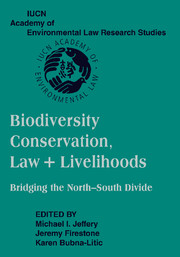 Biodiversity Conservation, Law and Livelihoods: Bridging the North-South Divide
Biodiversity Conservation, Law and Livelihoods: Bridging the North-South Divide Published online by Cambridge University Press: 31 July 2009
INTRODUCTION
Most of the economies of developing countries are heavily dependent on biodiversity resources. This is evidenced by the facts that agriculture produces the lion's share of GDP (greater than 30 percent) in most African countries and more than 60 percent of the employment for the rural population. The importance of biodiversity for socio-economic development is even more critical in the Ethiopian context. For instance, about 85 percent of the rural population of Ethiopia depends directly on agriculture, which again contributes 85 percent of exports mainly generated from coffee, skin, and hides. It is also reported that 45 percent of the country's GDP is contributed by the agricultural sector. The overwhelming majority of the rural population of Ethiopia, about 80 percent, depends on herbal medicine. The noneconomic aspects of biodiversity use, such as global climate regulation, hydrological regime, oxygen production, and so on, are vital components of biodiversity. However, these resources are being lost at an unprecedented level and would put the life-support systems of these nations at stake.
Despite their multiple ecological functions and immense uses for socioeconomic development, the country's biodiversity resources are being destroyed in critical proportions. The large-scale destruction of the forest resources is clear evidence. Nearly 40 percent of the country's total area was covered with forests at the beginning of the twentieth century. This was reduced to 16 percent in the 1950s and to roughly 3 percent in the 1990s.
To save this book to your Kindle, first ensure no-reply@cambridge.org is added to your Approved Personal Document E-mail List under your Personal Document Settings on the Manage Your Content and Devices page of your Amazon account. Then enter the ‘name’ part of your Kindle email address below. Find out more about saving to your Kindle.
Note you can select to save to either the @free.kindle.com or @kindle.com variations. ‘@free.kindle.com’ emails are free but can only be saved to your device when it is connected to wi-fi. ‘@kindle.com’ emails can be delivered even when you are not connected to wi-fi, but note that service fees apply.
Find out more about the Kindle Personal Document Service.
To save content items to your account, please confirm that you agree to abide by our usage policies. If this is the first time you use this feature, you will be asked to authorise Cambridge Core to connect with your account. Find out more about saving content to Dropbox.
To save content items to your account, please confirm that you agree to abide by our usage policies. If this is the first time you use this feature, you will be asked to authorise Cambridge Core to connect with your account. Find out more about saving content to Google Drive.